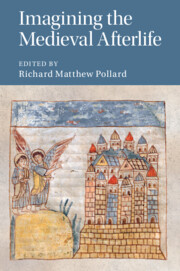Book contents
- Imagining the Medieval Afterlife
- Cambridge Studies in Medieval Literature
- Imagining the Medieval Afterlife
- Copyright page
- Contents
- Figures
- Contributors
- Preface and Acknowledgements
- Abbreviations
- Imagining the Medieval Afterlife: Introduction
- Part I Chronological Surveys
- Part II Theological Perspectives
- Part III Artistic Impressions
- Part IV Notable Authors and Texts
- Chapter 12 Visions and the Afterlife in Gregory’s Dialogues
- Chapter 13 The Vision of Tnugdal
- Chapter 14 The Afterlife in the Visionary Experiences of the Female Mystics
- Chapter 15 Dante’s Other-Worldly Surprises and This-Worldly Polemic
- Bibliography
- Index
- Cambridge Studies in Medieval Literature
Chapter 14 - The Afterlife in the Visionary Experiences of the Female Mystics
from Part IV - Notable Authors and Texts
Published online by Cambridge University Press: 07 December 2020
- Imagining the Medieval Afterlife
- Cambridge Studies in Medieval Literature
- Imagining the Medieval Afterlife
- Copyright page
- Contents
- Figures
- Contributors
- Preface and Acknowledgements
- Abbreviations
- Imagining the Medieval Afterlife: Introduction
- Part I Chronological Surveys
- Part II Theological Perspectives
- Part III Artistic Impressions
- Part IV Notable Authors and Texts
- Chapter 12 Visions and the Afterlife in Gregory’s Dialogues
- Chapter 13 The Vision of Tnugdal
- Chapter 14 The Afterlife in the Visionary Experiences of the Female Mystics
- Chapter 15 Dante’s Other-Worldly Surprises and This-Worldly Polemic
- Bibliography
- Index
- Cambridge Studies in Medieval Literature
Summary
This chapter characterises visionary experiences of heaven, hell, and purgatory received by medieval religious women.The twelfth-century Benedictines Hildegard of Bingen and Elisabeth of Schönau offer detailed representations of a celestial city but fewer specifics regarding the netherworld.Hildegard’s perception of the cosmos informs her view of heaven, whereas for Elisabeth it symbolises a longed-for end to life’s journey.Among the Cistercian women residing at Helfta in the thirteenth century, the graphic descriptions of otherworldly realms described by Mechthild of Magdeburg in The Flowing Light of the Godhead are most remarkable.For her contemporaries, Mechthild of Hackeborn and Gertrude the Great, the joyous union with Christ on earth is emphasised equally with the union in heaven.The striking scenes depicting the judgement of sinners in purgatory found in the revelations of the fourteenth-century saint Birgitta of Sweden serve as an admonition to her more secular audience.
Keywords
- Type
- Chapter
- Information
- Imagining the Medieval Afterlife , pp. 264 - 285Publisher: Cambridge University PressPrint publication year: 2020

